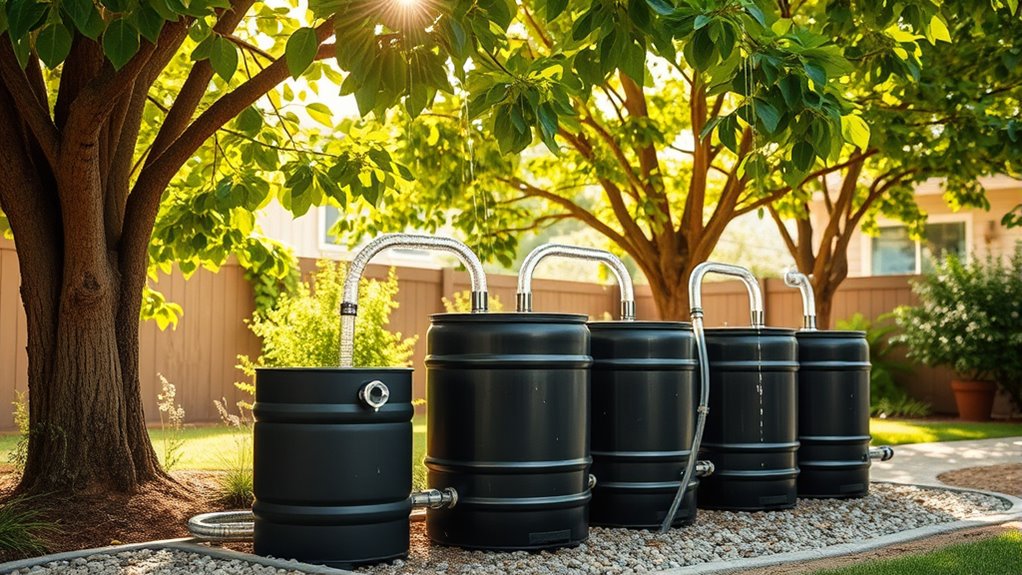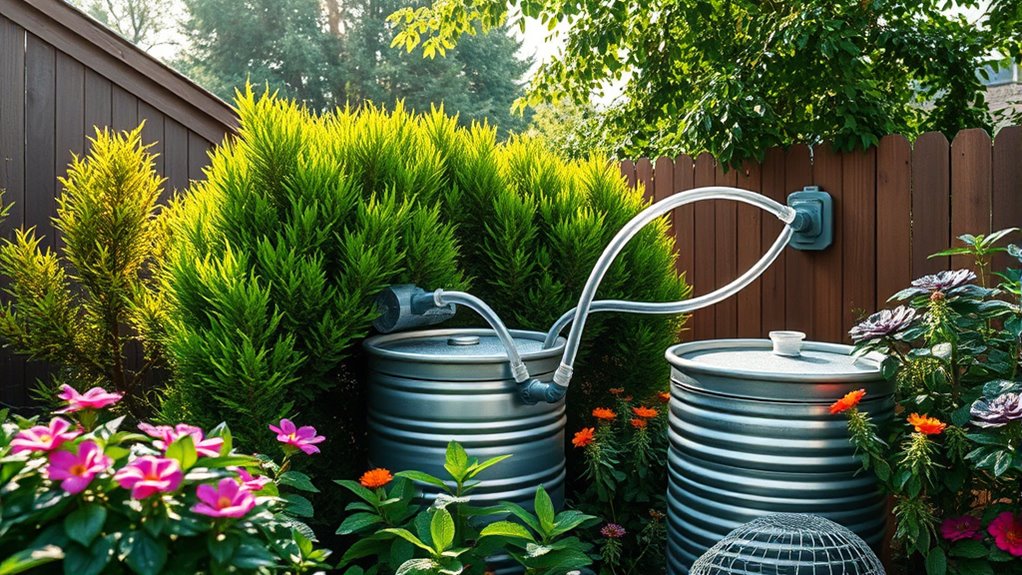Installing a rainwater harvesting system in your backyard is an eco-friendly way to conserve water and reduce runoff pollution. By capturing rain from your roof into gutters and tanks, you decrease reliance on municipal supplies and lower water bills. Proper filters and maintenance guarantee clean water for garden use or household tasks. Plus, such systems help prevent erosion and protect waterways. Keep exploring to discover how to set up an efficient, sustainable rainwater system tailored to your backyard needs.
Key Takeaways
- Installing a rainwater harvesting system reduces runoff, promotes eco-friendly water use, and supports sustainable backyard landscaping.
- Systems include gutters, storage tanks, filters, and purification devices for clean, chemical-free water.
- Rainwater harvesting decreases reliance on municipal supplies, lowering water bills and conserving energy.
- Proper maintenance and filtration ensure high-quality water suitable for irrigation and household uses.
- Eco-friendly backyard rainwater systems help prevent pollution and support environmental conservation efforts.

Have you considered how rainwater harvesting systems can transform your approach to water management? Installing such a system in your backyard isn’t just an eco-friendly move; it’s a smart way to conserve water, reduce costs, and support sustainable living. At its core, a basic rainwater harvesting setup includes three essential parts: a catchment area, a channeling system, and a collection container. Your roof acts as the catchment, directing runoff into gutters that channel water into a storage tank, often called a cistern. To improve water quality and system efficiency, you might add components like first flush diverters, which discard the initial dirty runoff, filter screens, filtration units, and purification devices. These ensure the water you collect is clean enough for various uses, whether for watering plants or even household tasks.
The key parts of your system include the cistern, gutter system, overflow pipe, and outlet pipe. The cistern stores the collected rainwater, while the gutter system captures and directs the runoff. When the cistern fills up, an overflow pipe channels excess water safely away, preventing flooding or damage. An outlet pipe then draws water from the tank for use in your garden or other applications. If your underground tank is part of the setup, a water pump—often a submersible type—may be necessary to maintain water pressure and facilitate flow. More complex systems can incorporate additional pumping, filtration, and purification steps, making the water suitable for drinking or other potable uses. Proper maintenance of the entire system is essential to ensure continued water quality and functionality over time.
Beyond conserving water, rainwater harvesting benefits the environment considerably. It reduces stormwater runoff, which often carries pollutants like pesticides, metals, and fertilizers into local waterways. By capturing rainwater on your property, you decrease the volume and velocity of runoff, helping to prevent streambank erosion and pollution. These systems also support municipal stormwater management efforts by controlling runoff at the source. Plus, rainwater used for irrigation doesn’t contain chemicals like fluoride or chloramines found in municipal water, making it gentler on your plants. Incorporating stormwater management practices with your system can further enhance environmental protection.
Rainwater harvesting reduces runoff pollution and protects waterways naturally.
Using harvested rainwater cuts down your dependence on municipal supplies, conserving treated freshwater and reducing your water bills. During droughts, your system could even help you bypass restrictions, ensuring a steady supply for your garden. Since locally captured water requires less energy for treatment and distribution, it also lowers your overall carbon footprint. Gravity-fed systems, which rely on natural gravitational force to move water, are especially energy-efficient, often eliminating the need for pumps. When pumps are necessary, choosing efficient submersible models ensures minimal energy use.
Effective rainwater systems incorporate filtration stages to guarantee clean water for various purposes. From debris removal to advanced purification, these steps make harvested rainwater safe for irrigation or, with proper treatment, for household use. Implementing a rainwater harvesting system in your backyard is a practical, sustainable choice that benefits your wallet, your garden, and the planet.
Frequently Asked Questions
How Much Does a Rainwater Harvesting System Typically Cost?
You’re wondering about the typical cost of a rainwater harvesting system. Prices vary based on size and complexity. Basic above-ground systems usually cost between $200 and $2,500, perfect for small gardens. Larger, underground or surface runoff systems can range from $6,500 to over $30,000, ideal for extensive needs. Consider your water needs and space to choose the right system, balancing initial investment with long-term benefits.
Are There Any Legal Restrictions on Installing Rainwater Harvesting in My Area?
You might be surprised, but your area could have some rules about rainwater harvesting. Most states allow it, but a few, especially in the West, have restrictions due to water rights and environmental concerns. You’ll need to verify local laws, permits, or registration requirements, especially for larger systems. Staying informed ensures you install your system legally, avoid fines, and maybe even qualify for incentives or rebates.
What Maintenance Is Required for a Rainwater Harvesting System?
You need to regularly maintain your rainwater harvesting system to keep it functioning properly. Inspect and clean your roof and gutters to prevent debris buildup, and clear out downspouts and screens to avoid clogs. Check storage tanks for leaks and sediment, clean filters quarterly, and test treatment systems monthly. Proper maintenance guarantees water quality and system longevity, helping you get the most eco-friendly benefits from your setup.
Can Rainwater Harvesting Systems Be Used Indoors?
You can use rainwater harvesting systems indoors, but it’s more complex. You’ll need specialized catchment areas like skylights or windows, along with filtration and purification to guarantee water quality. Installing indoor tanks, pumps, and plumbing is necessary, and regular maintenance helps prevent mold and bacteria. While it’s feasible for non-potable uses like flushing and cleaning, check local regulations and consider costs before setting up an indoor system.
How Much Water Can a Typical Backyard System Collect Annually?
Imagine your backyard as a treasure chest waiting to be filled. With a typical system, you can collect between 1,000 to 5,000 gallons annually, depending on your roof size and local rainfall. A 1,500 sq. ft. roof in a moderate climate could harvest around 2,000 gallons each year. Proper sizing guarantees you maximize this hidden wealth, turning your backyard into a sustainable resource hub.
Conclusion
By building a beautiful, budget-friendly rainwater harvesting system, you boost your backyard’s sustainability and save on water bills. Embrace eco-friendly efforts, enhance your environment, and enjoy the endless benefits of this beneficial backyard idea. With simple steps, you can create a clever, cost-effective collection, conserving resources while cultivating a greener, greater garden. Start today, and watch your backyard bloom into a bold, beautiful, and environmentally-elevating oasis.








